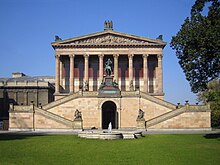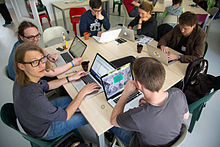GLAM/Resources/LearningGuides/How to start a successful GLAM partnership/pl
Collaborations between GLAM volunteers, GLAM institutions and Wikimedia Deutschland are diverse and very flexible – which is exactly what makes them so exciting for all involved. Despite their diversity, WMDE’s experience with almost 100 GLAM partnerships has allowed us to arrive at a set of general recommendations. The following “checklist” provides tips on what to watch out for and what to avoid when beginning to form a partnership with a GLAM institution.
Preparation

Being well prepared for the first meeting is the best foundation for success when initiating a partnership. You should check if possible the following questions in advance. The answers indicate if the cooperation is beneficial from the Wikimedia perspective. If this cannot be done in advance keep them as open questions for the meeting. If most answers turn out to be “No”, than it will be hard to still argue in favor of the cooperation.
Content
- The first question to consider when pursuing a possible partnership is: Does the institution possess content that could be of interest to a Wikimedia project? Such content may include historical artefacts, scientific databases, catalog entries, or material such as film, photographs, graphics, or scans of objects.
- The second question concerning content would be: Is the content already available in digital format? If so, to what extent? If your research doesn’t provide a satisfactory answer to this question in advance, it should be discussed at the initial meeting.
- The third question concerns the copyright status of the digitized content. Check the institution’s website, for example, prior to the meeting, as it may contain information on the re-use of its data. Generally, even with institutions like the Rijksmuseum, such information will be hidden in the information next to the object display, in the publishing details, or in the terms and conditions (if it is even available at all). If the content is to be regarded as in the public domain, or if it can be assumed that the institution is in the legal position to make decisions about licensing, this is worth discussing in the meeting.
Wolontariusze

- Even if an institution does not offer any exciting content for Wikimedia projects, a partnership could still be beneficial. A library that only houses copyright-protected material, for example, may express an interest in collaborating with Wikimedia. In this instance, you should check whether the institution has any other resources that could be of interest to Wikimedia volunteers. Such resources might include space for holding edit-a-thons or access to reference texts on special topics. Alternatively, the institution might be able to offer something you could use to thank your volunteers for their hard work and commitment. An exclusive behind-the-scenes tour of a theater, for example, would be a good opportunity to show your volunteers how much their support is valued.
- It is important to involve Wikimedia project volunteers in discussions about potential partnerships as early as possible, to determine whether they themselves would be interested in such a collaboration. After all, sooner or later every partnership will require volunteer engagement. If the volunteers are not interested, then this particular partnership can (and should) be given low priority.
- An entirely different question regarding volunteers is whether the institution itself has a good pool of volunteers who could be won over for the Wikimedia cause through collaborating with Wikimedia project volunteers. Viewed from this angle, a discussion with a historical society could be quite exciting even if we cannot expect to gain any interesting open content.
Once there is a positive response to the questions and/or a positive assessment, your Wikimedia organization’s benefits from a partnership will become more clear.
Osoba kontaktowa
The higher-ranking your contact person is, the better. It is also an advantage if the contact person has previous experience with Wikimedia projects and has worked with volunteers before. The meeting should last at least one hour. You can send material such as a GLAM brochure (this example is in German) to the contact person prior to the meeting so that he or she gets an idea of the opportunities that a Wikimedia partnership provides. Making the actual appointment you may thus refer to the arguments and contents of the brochure and agree that these topics will be further enrolled in the meeting.
The Meeting
Aim
Collaborating means working on something together. Everyone knows that motivation to work increases when there is a clear benefit to the partner. It is therefore important that you present strong arguments as to why a partnership with Wikimedia is beneficial for a GLAM institution. Make sure that you have checked all the points mentioned above in advance and have a clear goal in mind. The ultimate aim is a win-win situation.
Struktura
The initial meeting usually has an informal structure:
- Small talk
- Introductions
- Arguments for collaboration
- Presentation of own interests
- Pointing out opportunities presented by collaboration
- Discussion of potential obstacles
- Reaching agreement / decision on next steps
Argumenty
Presence: By collaborating with Wikimedia, an institution can increase its online presence through including its content or contributions in Wikimedia projects. For the institution, this results in greater attention, more visitors both online and offline, more contributors, more sponsors, and ultimately greater importance – including with regard to grant funds. There is no guarantee that these things will happen, but the partnership greatly improves an institution’s prospects.
Findability: A partnership with Wikimedia makes it easier to find an institution’s content, metadata, etc., as it places it in a wider and more general context.
Others are doing it too: The fact that similar or notable institutions have already entered into collaboration with your Wikimedia organization is very powerful argument.
Understanding Wikimedia: There is no ignoring the “Wikimedia phenomenon” – it is just as important for institutions to understand and, ideally, get involved with this phenomenon as it is to have a website and be active on social media.
Nowe perspektywy: The free re-use of data and content can give rise to new products and issues that help the institution tap into new target groups.
Social responsibility / Educational mandate: Citizens have a right to access cultural content that has been financed by tax revenues.
Opportunities presented by the collaboration

What can we achieve together? To answer this question you should try to paint as clear a picture as possible of what form the partnership could take. At the same time, however, make it clear that the collaboration can be developed in a very individual way. We recommend suggesting some of the tried-and-tested collaboration formats below in the meeting to help illustrate the concept behind the partnership. The arguments listed above can easily be woven into this part of the discussion. Formats offered by Wikimedia Deutschland:
- KulTour
- Wikiversum World Café
- Incorporating QRpedia codes
- GLAM on Tour
- Coding da Vinci
- ©© change your mind
- Wikipedian in Residence
- ...
Choosing a format


How do you decide which format is most suitable?
- Checking the GLAM questionnaire in the meeting, which you can find in the GLAM brochure, should help provide an initial overview of the situation.
- An institution with no previous experience of collaborations with Wikimedia should start off with formats such as KulTour or GLAM on Tour. These events allow volunteers and employees of the institution to learn more about a topic of common interest and to develop content together.
- The Wikiversum World Café is a very good format for new collaborations as it informs employees or volunteers of a GLAM institution about Wikimedia projects and motivates them to get personally involved. However, the World Café format is only suitable if the institution can provide at least 20 participants of its own for the event.
- A QRpedia project requires many volunteers who are willing to write missing articles in various languages. The institution must be prepared to display the QRpedia codes and the Wikimedia Foundation must allow for the use of the Wikipedia logo.
- To participate in Coding da Vinci, the institution must already have a large number of digitized data sets and be willing to make these data available under a free license.
- ©© change your mind is a fun workshop for employees of GLAM institutions that aims to facilitate the designation of content with a free license.
- Sending out a Wikipedian in Residence is only effective if the institution has not only laid the groundwork for free licenses and digitization, but has also begun the necessary work involved. The Wikipedian in Residence can then train and advise his or her colleagues in creating closer ties to the Wikiverse.
Determining the next steps
At the end of the meeting, both sides should have a clear idea of what is to be done next and what joint activities are to be planned. Ideally, you should send a follow-up e-mail thanking your contact for the meeting and reiterating in writing any agreements that were made. When will what be done and by whom? When must which steps be taken?
It can also be useful, particularly from an organizational perspective, to draw up a collaboration agreement where all participants’ tasks and work packages are put down in writing and signed by both parties. Many institutions are used to working within clearly defined processes and will appreciate this. Commitment is the key foundation of any collaboration – it creates trust. So be careful not to promise anything you won’t be able to deliver.
Snags and Obstacles
Of course, there are always going to be things that make collaboration difficult. Here are some brief reminders of obstacles you may encounter:
- The issue of free licenses is often a sticking point when deciding whether to enter into a collaboration. For example, an institution hosting a photo excursion as part of a KulTour has the right to prohibit commercial re-use of the images. But then it would be of no use to Wikimedia volunteers to take any photos.
- Collaboration can be logistically difficult if a project requires the participation of volunteers, but the institution is only available for collaborative work during regular working hours.
- If an institution believes it has the right to final edit or even prohibit the publishing of Wikipedia articles that arise through the collaboration, or to influence any other volunteer activities, it is mistaken. The volunteers are free to decide how they work. This should be clearly communicated beforehand.
- No one can guarantee the institution that formats involving the participation of Wikimedia project volunteers will end up exactly as planned. These activities are open and based on voluntary contribution. This can cause frustration, so it is important to mention the possibility of failure early on to keep disappointment to a minimum.
- Keep in mind, that for many institutions it might still be unusual not to have an institutional partner but volunteers to cooperate with. In this case your local Wikimedia organization could fill the gap as intermediary.
Of course, these are just a few tips that we recommend you bear in mind when first meeting with an institution. The most important foundations for collaboration are trust, patience and perseverance. Sometimes an institution is actually interested, but it is just not the right moment. In these instances, broaching the subject again at a later date might still result in a partnership. Usually, showing a genuine interest in the institution and its valuable content during the meeting will convince your contact partner to enter into a collaboration. Everything else ultimately comes down to negotiating skills and a good dose of luck to be in the right place at the right time.
